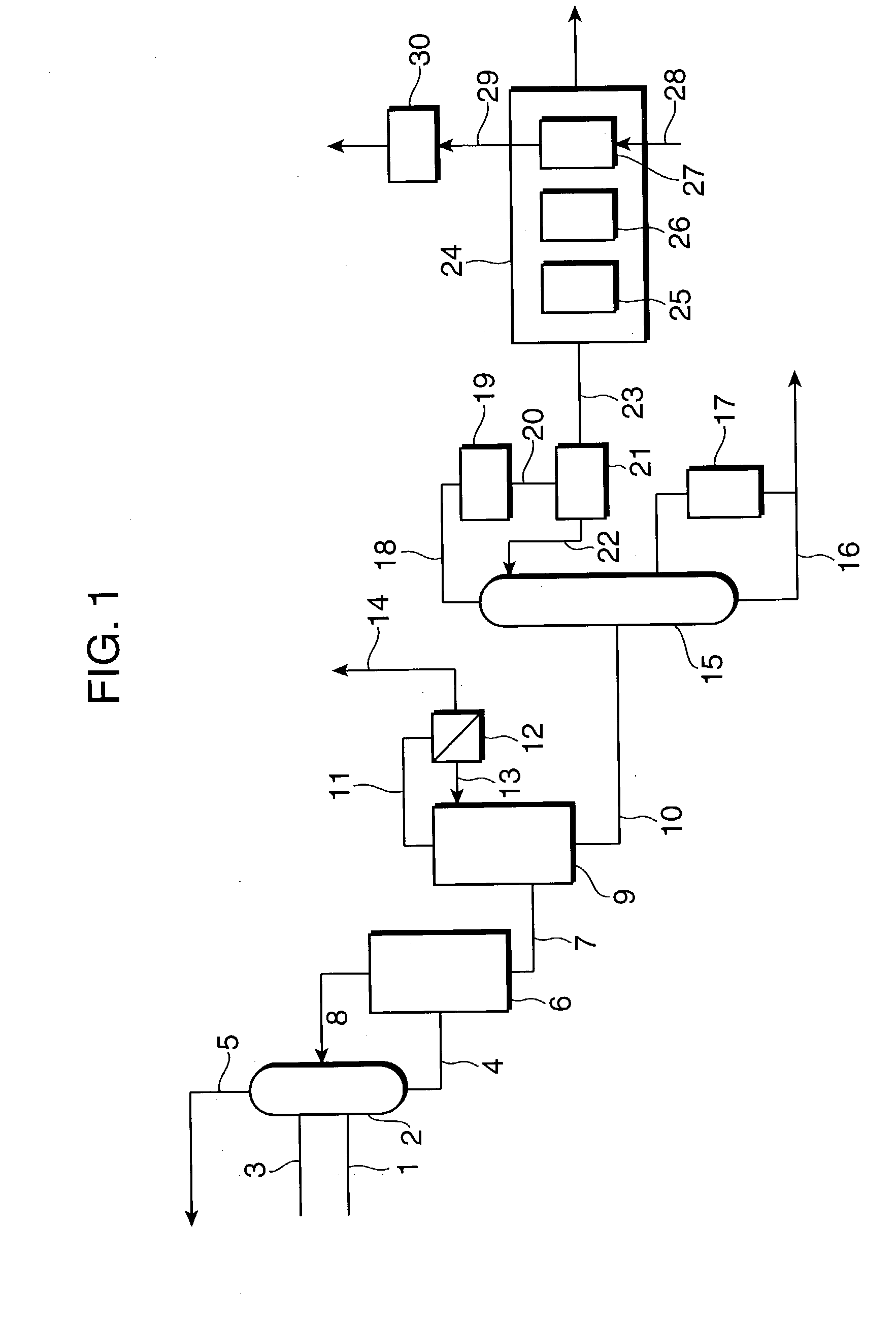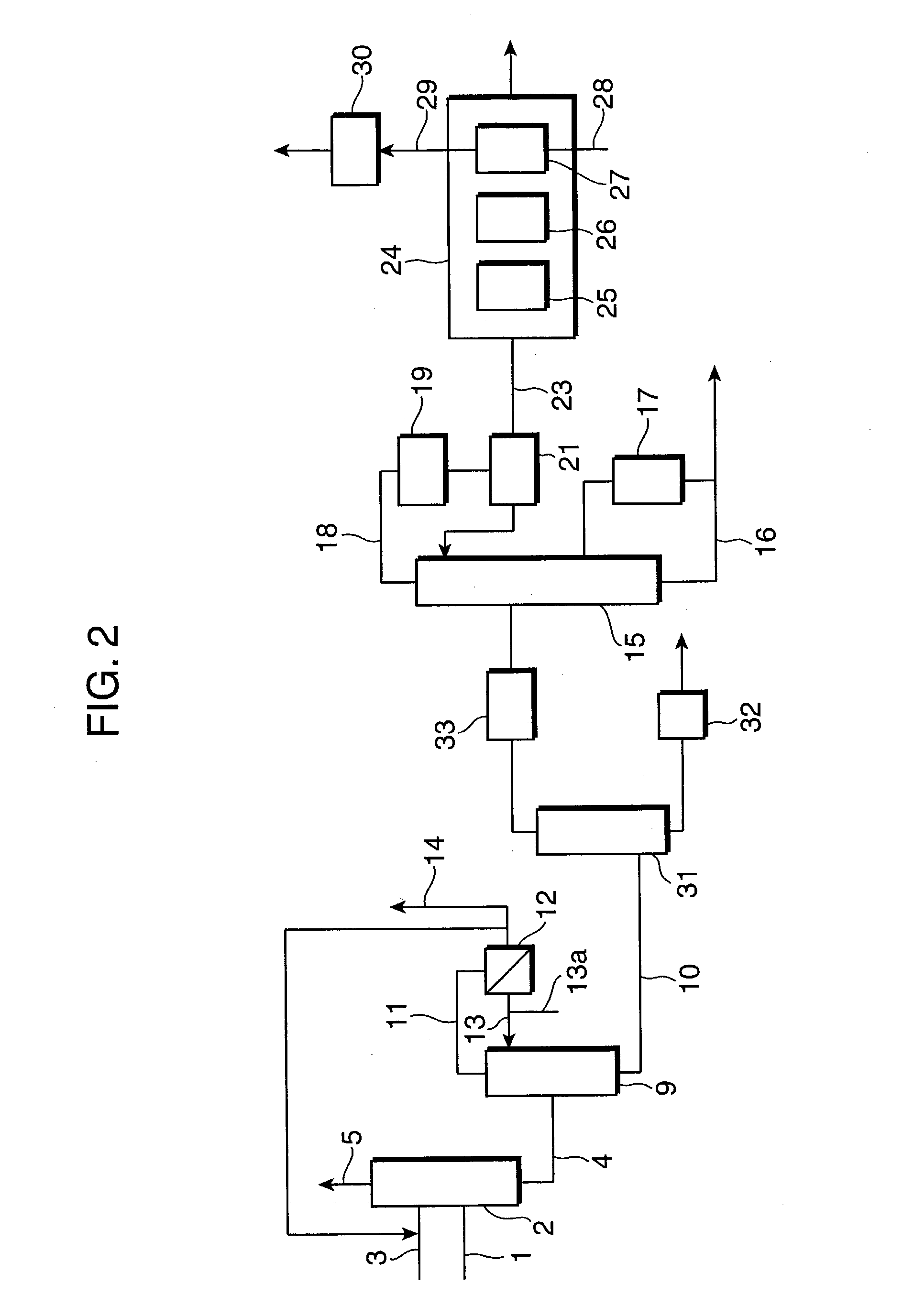Process for treating wastes from acrylic acid and polyacrylic acid production processes
a technology of polyacrylic acid and waste, which is applied in the direction of separation process, combustion type, treatment water nature, etc., can solve the problems of clogging of combustion furnace and heat exchanger, high combustion cost,
- Summary
- Abstract
- Description
- Claims
- Application Information
AI Technical Summary
Problems solved by technology
Method used
Image
Examples
example 1
[0051] A gas containing acrylic acid obtained by gas-phase oxidation of raw gases containing propylene was fed via line 1 into absorption column 2, and distilled water from distillation column 9 was fed as an absorption solvent via line 3 into the same absorption column, to give an acrylic acid solution. The acrylic acid solution was supplied to azeotropic distillation column 9 and an azeotropic solvent was fed via line 13a into the azeotropic distillation column. Low boiling impurities containing water are separated as the distillate from the top of the column. The distillate was fed into an apparatus for separating azeotropic solvents (decanter) 12, and after oil / water separation, a part of the aqueous phase was recycled to absorption column 2, and the other part was discharged (1.7 m3 / h) via line 14 as a waste water (hereinafter, referred to as "waste water A"). Meanwhile, the waste water A had a composition of 1.8 mass % of acrylic acid, 5.7 mass % of acetic acid, and the balanc...
example 2
[0053] The waste gas (containing 1000 vol. ppm of acrylic acid and 19.8 vol. % of water) discharged (555 Nm.sup.3 / min) from the top of the absorption column in the acrylic acid production process described in EXAMPLE 1 above, and the hot waste gas (containing 30 vol. ppm of acrylic acid and 19.8 vol. % of water) discharged (300 Nm.sup.3 / min) from the water-absorbent resin production process were preheated in a plate heat exchanger and supplied to and burned in a catalytic combustion apparatus. After a month of operation, there was no deposit in the heat exchanger found upon inspection.
example 3
[0054] The waste gas (containing 1000 vol. ppm acrylic acid and 19.8 vol. % of water) discharged (555 Nm.sup.3 / min) from the top of the absorption column in the acrylic acid production process described in EXAMPLE 1, the waste water A discharged (1.7 m.sup.3 / h) after oil / water separation of the distillate form the top of the azeotropic distillation column, and the hot waste gas (containing 30 vol. ppm of acrylic acid and 19.8 vol. % of water) discharged (300 Nm.sup.3 / min) from the water-absorbent resin production process are supplied to an combustion furnace. The waste gas, the waste water A, and the hot waste gas above are fed and burned in the combustion furnace that is separately supplied with natural gas to maintained the internal temperature at 900.degree. C., giving a purified non-hazardous gas to be released outside.
PUM
| Property | Measurement | Unit |
|---|---|---|
| temperature | aaaaa | aaaaa |
| temperature | aaaaa | aaaaa |
| mass % | aaaaa | aaaaa |
Abstract
Description
Claims
Application Information
 Login to View More
Login to View More - R&D
- Intellectual Property
- Life Sciences
- Materials
- Tech Scout
- Unparalleled Data Quality
- Higher Quality Content
- 60% Fewer Hallucinations
Browse by: Latest US Patents, China's latest patents, Technical Efficacy Thesaurus, Application Domain, Technology Topic, Popular Technical Reports.
© 2025 PatSnap. All rights reserved.Legal|Privacy policy|Modern Slavery Act Transparency Statement|Sitemap|About US| Contact US: help@patsnap.com


